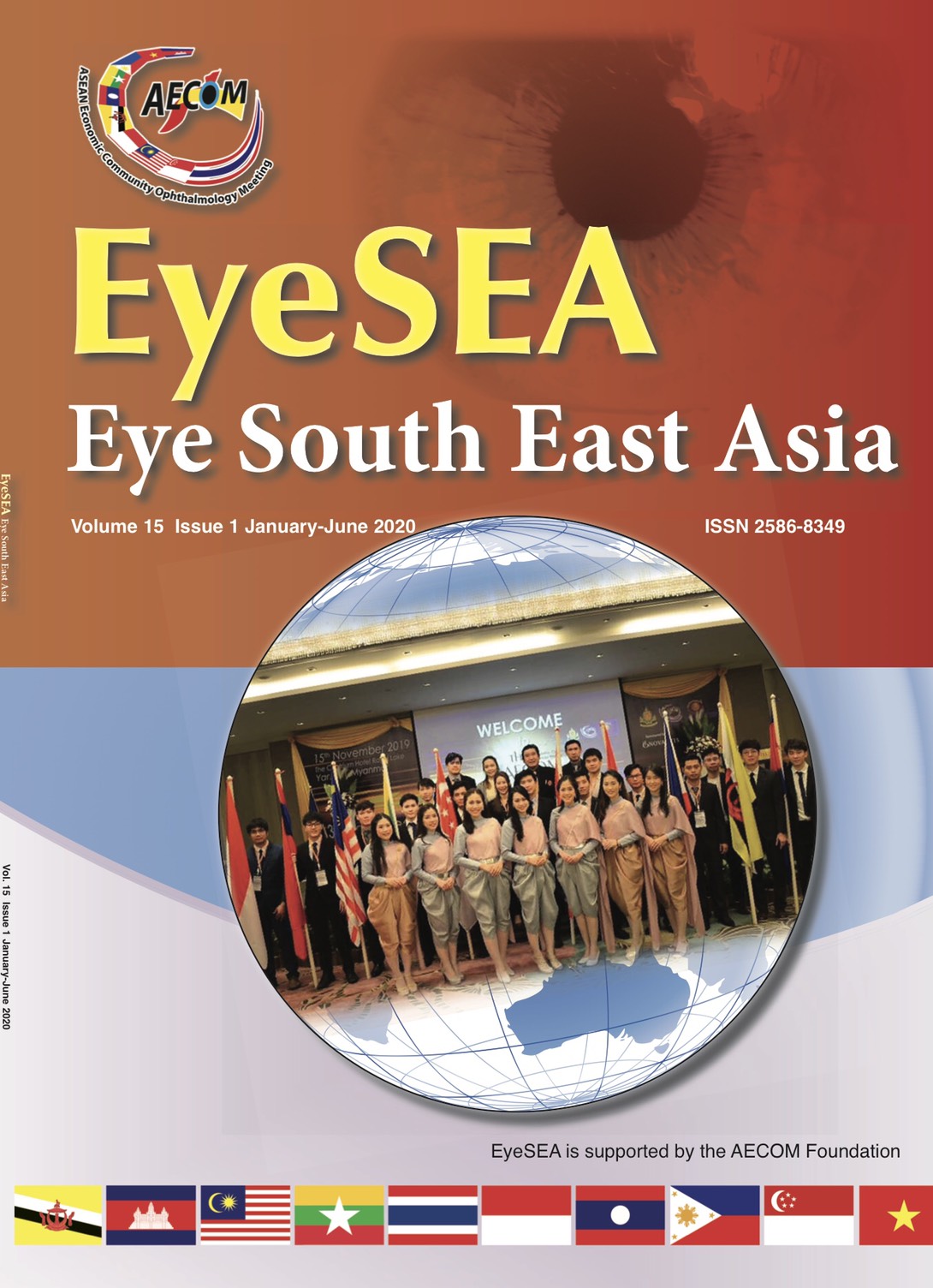Ocular gnathostomiasis in Myanmar: Two cases and literature survey
Main Article Content
Abstract
Background: To report two cases of indigenous ocular gnathostomiasis in Myanmar with the update of the current status of this disease in Myanmar by literature survey.
Results: Two middle-aged women, 55-year-old and 40-year-old, living in Yangon, Myanmar, presented individually to two different hospitals with several weeks history of blurred vision. In both cases, a live worm of about 4-5 mm was found moving in the anterior chamber of the eye in association with inflammatory cell infiltration. The worm in the anterior chamber of each patient was successfully removed by microscopic surgery. The visual acuiety of the patients returned to normal after removal of the worm. Literature survey revealed that, including 2 cases reported hetre, the number of cumulative cases of ocular gnathostomiasis in Myanmar exceeds 20 cases, the worst record in the world.
Conclusions: Since ocular gnathostomiasis is an extremely rare form of gnathostomiasis, thausands of cutaneous and/or visceral cases have been undiagnosed in Myanmar. Nationwide epidemiological survey for gnathostomiasis of any form should be performed.
Article Details
References
2. Miyazaki I. On the genus Gnathostoma and human gnathostomiasis, with special reference to Japan. Experimental Parasitology. 1960 Jun 1;9(3):338-70.
3. Vonghachack Y, Dekumyoy P, Yoonuan T, Sa-nguankiat S, Nuamtanong S, Thaenkham U, et al. Sero-epidemiological survey of gnathostomiasis in Lao PDR. Parasitol Int 2010;59:599-605.
4. Xuan LT, Hoa PTL, Dekumyoy P, Hoan NH, Khuong LH, Van TTH, et al., Gnathostoma infection in South Vietnam. Southeast Asian J Trop Med Publ Health 2004;35(suppl 1):97-9.
5. Nawa Y, Katchanov J, Yoshikawa M, Rojekittikhun B, Dekumyoy P, Kusolusuk T, et al. Ocular gnathostomiasis: A comprehensive review. J Trop Med Parasitol 2010;33:77-86.
6. Wai AP, Maw WW, Moe AC, Boonmars T and Nawa Y. Human gnathostomiasis in Myanmar: a review of local literature. Southeast Asian J Trop Med Publ Health 2018; 49(4):543-548.
7. Kurokawa M, Ogata K, Sagawa S, Miyaoka Y, Noda S, Nawa Y. Cutaneous and visceral larva migrans due to Gnathostoma doloresi infection via an unusual route. Archives of dermatology. 1998;134(5):638-9.
8. Katchanov J, Sawanyawisuth K, Chotmongkol V, Nawa Y. Neurognathostomiasis, a neglected parasitosis of the central nervous system. Em Infect Dis. 2011;17(7):1174-1180.
9. Nawa Y, Yoshikawa M, Sawanyawisuth K, Chotmongkol V, Figueiras SF, Benavides M, et al. Ocular gnathostomiasis—update of earlier survey. The American journal of tropical medicine and hygiene. 2017 Oct 11;97(4):1232-4.
10. Chai JY, Han ET, Shin EH, Park JH, Chu JP, Hirota M, et al. An outbreak of gnathostomiasis among Korean emigrants in Myanmar. Am J Trop Med Hyg 2003;69(1):67-73.
11. Gyi K. Intra-ocular gnathostomiasis. British J Ophthalmol 1960;44:42-45.
12. Khin T. Intra-ocular gnathostomiasis. British J Ophthalmol 1968;52(1):57-60.
13. Mukherjee A, Ahmed NH, Samantaray JC, Mirdha BR. A rare case of cutaneous larva migrans due to Gnathostoma sp. Indian J Med Microbiol 2012;30:356-8
14. Subhedar V, Nandedkar S, Jain M, Bajpai T. (2014). Gnathostomiasis: a rare case of cutaneous creeping eruptions. Ind J Dermatopathol Diag Dermatol 2014; 1(1), 32-34.
15. Phetsouvanh R, Habe S, Newton P, Vongsouvaht M, Horii Y, Doanh PN, et al. Spontaneous emergence of a Gnathostoma spinigerum adult worm from the abdominal skin of a Laotian woman: a case report. Southeast Asian Journal of Tropical Medicine and Public Health. 2018;49(1):1-5.
16. Khin Maung Win. Eating raw fish is not a Myanmar food habit. Health Digest 2004; 2004; 1(32,33): April 21st and 28th.
17. Jung BK, Lee JJ, Pyo KH, Kim HJ, Jeong HG, Yoon CH, et al. Detection of Gnathostoma spinigerum third-stage larvae in snakeheads purchased from a central part of Myanmar. Korean J Parasitol 2008;46(4):285-288.
18. Chai JY, Sohn WM, Na BK, Park JB, Jeoung HG, Hoang EH, et al. Larval Gnathostoma spinigerum detected in Asian swamp eels, Monopterus albus, purchased from a local market in Yangon, Myanmar. Korean J Parasitol 2015;53(5):619-625.


